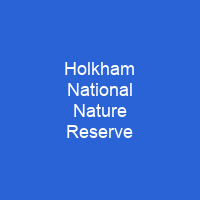Holkham National Nature Reserve: A Natural Gem in Norfolk
Imagine a place where nature reigns supreme, untouched by the hustle and bustle of modern life. That’s what Holkham National Nature Reserve is all about. Nestled on the Norfolk coast between Burnham Overy Staithe and Blakeney, this 3,900-hectare reserve is England’s largest national nature reserve, a true haven for wildlife enthusiasts and nature lovers alike.
The Diverse Habitat of Holkham
At Holkham, you’ll find a tapestry of habitats that paint a picture of natural beauty. From the grazing marshes where wildflowers bloom in spring to the salt marshes teeming with life, each corner of this reserve tells its own story. The sand dunes and foreshore areas are like nature’s playgrounds, offering endless opportunities for exploration and discovery.
Wildlife Wonders
But it’s not just about the scenery; Holkham is a treasure trove of wildlife. Think of it as a bustling city where every species has its own role to play. Wintering wildfowl like pink-footed geese and Brent geese flock here, while breeding waders such as lapwings and snipe make their homes in the marshes. Even rare invertebrates and plants find sanctuary here, including the unique antlion colony that makes Holkham one of only two sites in the UK to boast this distinction.
A Long History
While nature’s beauty is on full display today, Holkham has a rich history dating back centuries. The estate was first owned by the Coke family way back in 1609 and transformed into farmland from marshes in the 17th century. Holkham Hall, built between 1734 and 1764, stands as a testament to this storied past.
Challenges and Conservation
Despite its natural splendor, Holkham faces challenges that threaten its very existence. Climate change poses a significant risk with rising sea levels increasing the likelihood of flooding and coastal erosion. The underlying geology is Cretaceous chalk, exposed at Hunstanton cliffs, but the coastline has shown a less consistent pattern of accretion over time.
Half of the salt marshes that formed in the lee of Scolt Head Island have been reclaimed in the last 300 years, creating fragile grazing marshes. This is where conservation efforts come into play. The Norfolk Coast Partnership divides the coast into three zones for tourism development purposes, with Holkham Dunes and other sensitive habitats designated as red-zone areas with no development or parking improvements.
Management and Protection
The Environment Agency’s management plan until 2105 relies on natural protection. They intervene only if necessary due to a potential 1.1m sea level rise, ensuring that the dunes remain effective in protecting the low-lying areas of Holkham.
Scolt Head Island’s shingle is moving westwards at up to 3.5m per year, potentially affecting sediment movement and leading to erosion. However, this doesn’t necessarily mean the dunes are losing their effectiveness; they just need a bit more attention from nature’s own processes.
Recreation and Tourism
While Holkham is a sanctuary for wildlife, it also welcomes visitors who come to enjoy its natural beauty. The reserve attracts 7 million day visitors and 5.5 million overnight stays annually, generating £122 million and creating full-time jobs. But with such popularity comes the challenge of balancing human activity with conservation efforts.
Disturbance to breeding birds, trampling of plants, and erosion of dunes are just some of the negative impacts that come with increased visitor numbers. It’s a delicate balance, but one that Holkham is working hard to maintain through careful management and education initiatives.
A Future for Holkham
As we look towards the future, it’s clear that Holkham National Nature Reserve faces both challenges and opportunities. The key lies in sustainable practices that respect nature while allowing people to enjoy its beauty. By working together, we can ensure that this natural gem remains a place of wonder for generations to come.
So, next time you find yourself near the Norfolk coast, take a moment to explore Holkham National Nature Reserve. Let it inspire you and remind you of the importance of preserving our natural heritage.

You want to know more about Holkham National Nature Reserve?
This page is based on the article Holkham National Nature Reserve published in Wikipedia (retrieved on December 5, 2024) and was automatically summarized using artificial intelligence.







